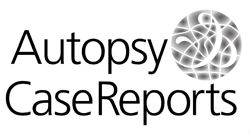Ovarian hydatid cyst mimicking an ovarian neoplasm
Darilin Shangpliang; Pakesh Baishya; Biswajit Dey; Vandana Raphael; Baphiralyne Wankhar
Abstract
Amongst the seven infective Echinococcus granulosus genotypes, G1 (sheep strain) is the most common genotype causing human disease worldwide.
The hydatid disease commonly affects the liver (60-75%) and the lungs (15-25%).
Although the seropositive cases of echinococcosis are increasing in the Indian subcontinent, ovarian involvement is rare, with few cases reported from India and none from the northeastern part of India.
A 37-year-old nulliparous woman sought medical care complaining of progressive increment of the abdominal girth over the last year. She had significant weight loss and low-grade fever for the last month. She had no associated history of nausea, vomiting, diarrhea, anorexia, or jaundice. Her menses were irregular since then, and micturition was difficult demanding urinary catheterization. Her medical history was unremarkable. She was a daily wage laborer working on a farm with a recent history of traveling from central India. The abdominal examination revealed a palpable firm irregular mass arising from the pelvis. She was admitted with the working diagnosis of ovarian cystadenoma and ipsilateral hydroureteronephrosis. The routine blood biochemistry, urine examination, and chest X-ray were normal. The alpha-fetoprotein (AFP), carcinoembryonic antigen (CEA), cancer antigen 15-3 (CA 15-3), and cancer antigen 125 (CA 125) were normal. The contrasted-enhanced computed tomography (CECT) scan of the abdomen and pelvis revealed a large (14.8x12.6x9.5 cm) multiseptated cystic lesion in the Pouch of Douglas, consistent with the ovarian origin and ipsilateral hydroureteronephrosis (
The gross specimen consists of an already ruptured cystic mass, measuring 12.5x9x0.5 cm along with multiple whitish vesicles ranging in size from 6.5-0.5cm (
Females are at higher risk for acquiring echinococcosis, and this increased risk has been attributed to active female participation in farming and herding of livestock in the rural communities.
Ovarian hydatidosis usually presents with non-specific symptomatology such as abdominal pain, swelling, infertility, and pressure symptoms due to mass effect on the pelvic organs.
Ovarian echinococcosis can mimic either a polycystic disease or malignancy of the ovary. The diagnostic challenge is due to the non-specific clinical symptomatology.
Serodiagnostic assays are very helpful in confirming the diagnosis and have a sensitivity ranging from 64-87%.
The ideal treatment for ovarian hydatid cyst is surgical excision, which could be either radical or conservative. Care must be taken to avoid perioperative rupture of the cyst.
Awareness regarding echinococcal ovarian cyst, especially in endemic areas, will avoid the diagnostic problems and potentially serious complications.
References
Ann Trop Med Public Health.
Ultrasound Obstet Gynecol.
Am J Case Rep.
Clin Microbiol Rev.
Int J Reprod Contracept Obstet Gynecol.
Int J Reprod Contracept Obstet Gynecol.
Int J Surg Case Rep.
J Assoc Physicians India.
Aust N Z J Obstet Gynaecol.
J Turk Ger Gynecol Assoc.
J Med Soc.
Int J Reprod Contracept Obstet Gynecol.
Int J Sci Stud.
J Turk Ger Gynecol Assoc.
Publication date:
06/05/2020

